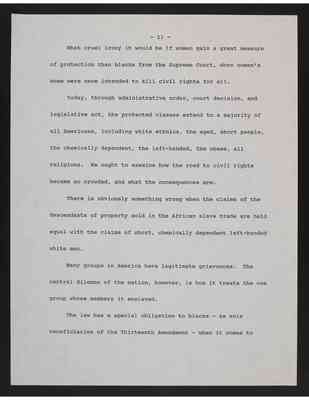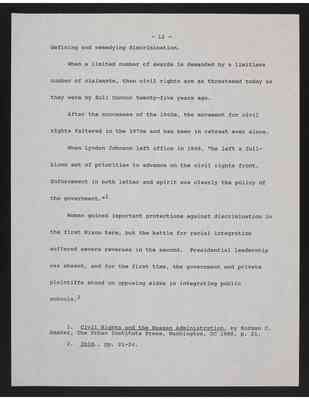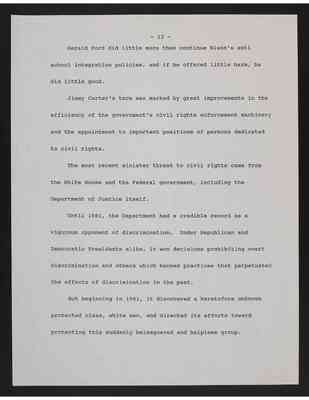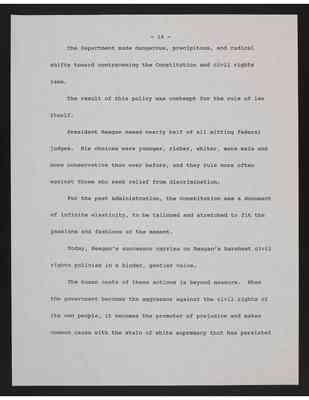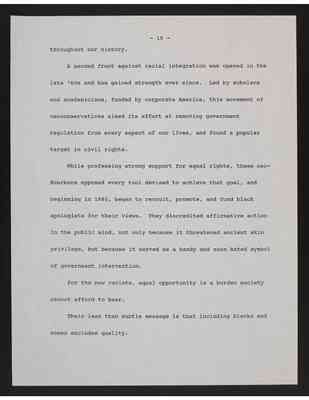Pages
11
- 11 -
What cruel irony it would be if women gain a great measure of protection than blacks from the Supreme Court, when women's woes were once intended to kill civil rights for all.
Today, through administrative order, court decision, and legislative act, the protected classes extend to a majority of all Americans, including white ethnics, the aged, short people, the chemically dependent, the left-handed, the obese, all religions. We ought to examine how the road to civil rights became so crowded, and what the consequences are.
There is obviously something wrong with the claims of the descendants of property sold in the African slave trade are held equal with the claims of short, chemically dependent left-handed white men.
Many groups in America have legitimate grievances. The central dilemma of the nation, however, is how it treats one group whose members it enslaved.
The law has a special obligation to blacks - as sole beneficiaries of the Thirteeth Amendemtn - when it comes to
12
- 12 -
defining and remedying discrimination.
When a limited number of awards is demanded by a limitless number of claimants, then civil rights are as threatened today as they were by Bull Connor twenty-five years ago.
After the successes of the 1960s, the movement for civil rights faltered in the 1970s and has been in retreat ever since.
When Lyndon Johnson left office in 1968, "he left a full-blown set of priorities to advance on the civil rights front. Enforcement in both letter and spirit was clearly the policy of the government."1
Women gained important protections against discrimination in the first Nixon term, but the battle for racial integration suffered severe reverses in the second. Presidential leadership was absent, and for the first time, the government and private plaintiffs stood on opposing sides in integrating public schools.2
1. Civil Rights and the Reagan Administration, by Norman C. Amaker, The Urban Institute Press, Washington, DC 1988, p. 21.
2. Ibid., pp. 21-24.
13
- 13 -
Gerald Ford did little more than continue Nixon's anti school integration policies, and if he offered little harm, he did little good.
Jimmy Carter's term was marked by great improvements in the efficiency of the government's civil rights enforcement machinery and the appointment to important positions of persons dedicated to civil rights.
The most recent sinister threat to civil rights came from the White House and the Federal government, including the Department of Justice itself.
Until 1981, the Department had a credible record as a vigorous opponent of discrimination. Under Republican and Democratic Presidents alike, it won decisions prohibiting overt discrimination and others which banned practices that perpetuated the effects of discrimination in the past.
But beginning in 1981, it discovered a heretofore unknown protected class, white men, and directed its efforts toward protecting this suddenly beleaguered and helpless group.
14
- 14 -
The Department made dangerous, precipitous, and radical shifts toward contravening the Constitution and civil rights laws.
The result of this policy was contempt for the rule of law itself.
President Reagan named nearly half of all sitting federal judges. His choices were younger, richer, whiter, more male and more conservative than ever before, and they rule more often against those who seek relief from discrimination.
For the past Administration, the Constitution was a document of infinite elasticity, to be tailored and stretched to fit the passions and fashions of the moment.
Today, Reagan's successor carries on Reagan's harshest civil rights policies in a kinder, gentler voice.
The human costs of these actions is beyond measure. When the government becomes the aggressor against the civil rights of its own people, it becomes the promoter of prejudice and makes common cause with the stain of white supremacy that has persisted
15
- 15 -
throughout our history.
A second front against racial integration was opened in the late '60s and has gained strength ever since. Led by scholars and academicians, funded by corporate America, this movement of neoconservatives aimed its effort at removing government regulation from every aspect of our lives, and found a popular target in civil rights.
While professing strong support for equal rights, these neo-Bourbons opposed every tool devised to achieve that goal, and beginning in 1980, began to recruit, promote, and fund black apologists for their views. They discredited affirmative action in the public mind, not only because it threatened ancient skin privilege, but because it served as a handy and soon hated symbol of government intervention.
For the new racists, equal opportunity is a burden society cannot afford to bear.
Their less than subtle message is that including blacks and women excludes quality.
